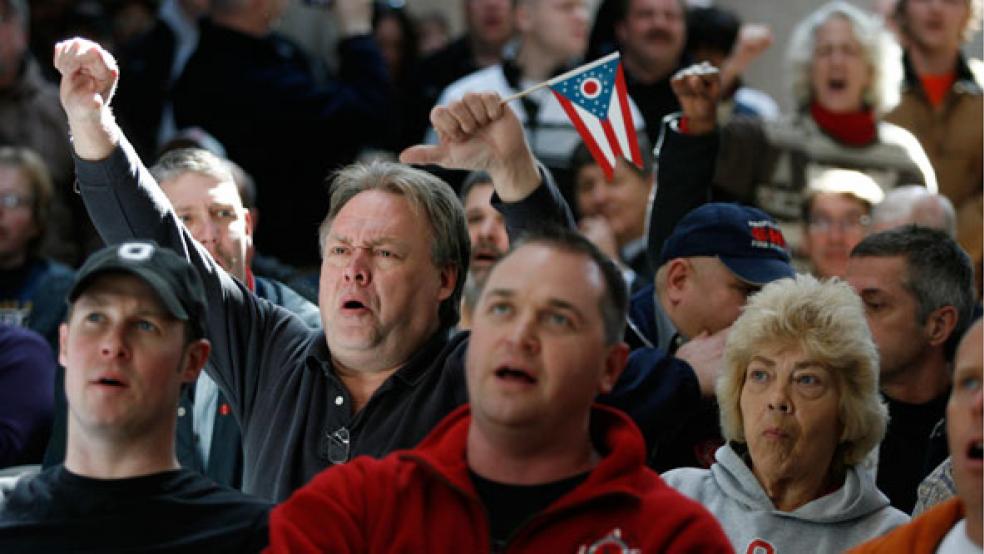What’s holding back job growth in America? Hint: It’s not the private sector.
The end of October marked another month where the slow-growing U.S. economy failed to hire enough unemployed Americans to make a significant dent in the jobless rate, which remains stuck at 9 percent.
But the top line number – just 80,000 new jobs – masks what has now become the defining feature of the sluggish rebound from the Great Recession. Another 24,000 layoffs among government workers partially offset the 104,000 new job opportunities created by U.S. businesses.
While this may come as a surprise, the private sector’s job growth rate over the past year, despite a series of shocks from a run-up in oil prices, the Japanese earthquake’s disruption of the auto supply chain, and ongoing turmoil in the European bond market, has been fairly typical by recent historical standards. Private-sector jobs have been growing at a slightly faster pace than the early 2000s but slightly slower than the early 1990s. Both of those rebounds were dubbed “jobless recoveries” at their starts.
But there is one factor that is very different this time around. Unlike those earlier recoveries, tentative early gains in private-sector employment have been accompanied by sharp cutbacks in government payrolls. Since July 2010, governments – mostly at the state and local level – have shed over 600,000 jobs. The private sector over that same 15 months has added 2.2 million jobs, an average of 147,000 a month.
The collapse of public-sector employment in the past year has been largely due to the sharp turn in government policy that occurred in the wake of the 2010 mid-term election. After Republicans won control of the House of Representatives, they rejected Obama administration efforts to provide state and local governments with new assistance.
The 2009 stimulus act, which had included hundreds of billions of dollars in aid to the states, failed to end the recession, they claimed. And while that may be so, it did preserve government jobs closest to people – in schools, fire and police departments, and road and bridge maintenance. Public-sector employment, which stood at 22.5 million workers in July 2008 when the recession hit in full force, actually climbed slightly over the next two years to 22.6 million jobs.
But when revenue-sharing with the states dried up, local employment began to plummet. Today, there are just 22 million jobs in the public sector.
Scott Lilly, a senior fellow at the left leaning Center for American Progress, who spent a long career as a budget analyst on Capitol Hill, estimates that the unemployment rate today would be about 8.7 percent or 8.8 percent if those public employees had remained on the job. And an unemployment rate that had continued to drop gradually might have prevented major declines in consumer and business confidence, which took nosedives over the past year.
“A 33 percent increase in employment growth over a 15-month period would have changed the complexion of the recovery and had a major impact on businesspeople who are sitting on the sidelines because they don’t know if this recovery is for real,” he said.
Of course, the impact of declining support for the states was predicted last December, when the lame-duck Congress passed a tax package whose only new stimulus was a cut in payroll taxes for wage earners and some new business breaks. Tax breaks, economists at Moody’s Analytics and analysts at the liberal-leaning Center on Budget and Policy Priorities pointed out, provide the least bang for the buck in terms of creating jobs since most of the money is either saved or used to pay bills by hard-pressed households still burdened by debts accumulated during the housing bubble years.
Aid to the states, on the other hand, almost dollar-for-dollar goes to preserving jobs, since the single biggest government expense is personnel. Keeping people on the job not only maintains public services, it allows those workers to continue consuming, which helps the private sector. Segments of the private sector also benefit from government contracts.
President Obama included more aid to the states in the current jobs bill he’s been touting on his barnstorming trips across the country. But like the other elements of the bill, it’s going nowhere. Political gridlock guarantees that public-sector cuts will continue to retard the economic recovery as the U.S. moves through an election year.




